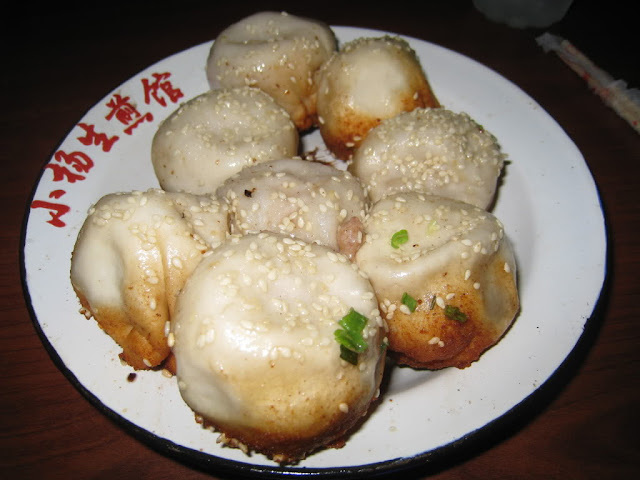eating shanghai
A guide to ordering and eating Chinese food
2/27/11
辣子鸡 làzǐjī spicy chicken
Laziji is a dish of deep-fried small pieces of chicken. The chicken pieces typically have some bone or gristle in them. Chinese people enjoy eating gristle. The chicken is surrounded by a large amount of dried chilies.
2/15/11
回锅肉 huíguō ròu twice-cooked pork
Huiguorou is originally from Sichuan, but it's so popular you can order at almost any type of restaurant. It literally means "return-to-the-pot pork." It's pieces of pork belly, aka bacon, stir fried with chilies and spring onions.
2/9/11
水煮鱼 shuǐzhǔyú boiled fish
Shuizhuyu is a huge bowl of pieces of fish sitting in boiling oil and dried chilies. It sounds gross, but it's actually really good. It makes me think that consuming oily things doesn't lead directly to getting fat, as Chinese people are some of the skinniest in the world. The fish will typically have bones in it unless you ask for a very un-bony fish. Chinese people have no problem eating around bones in fish or whatever meat. I've come to like meat with bones in it much more since I've been in China. I can no longer see what is appealing about a boneless, skinless chicken breast. Blech. Anyway, I'm not sure whether this dish is from Hunan or Sichuan. I've had it from both types of restaurants. The waiter will give you a slotted spoon so you can just eat the fish and not the oil.
番茄炒蛋 fānqié chǎodàn stir-fried tomato and egg
Fanqie chaodan is homestyle cooking. It doesn't even seem Chinese. It looks and tastes like scrambled eggs with tomato.
2/8/11
臭豆腐 chòudòufu stinky tofu
Stinky tofu is sold on the street, and when I got to Shanghai, I thought it was one of the worst smells I had ever smelled. It smells like acidic body odor. It took me about a year to work up the courage to actually eat some of it. It actually is not that bad, and now that I've eaten it, the smell no longer bothers me. It's not something that I crave, but I'll eat it if someone buys it. The smell comes from the fermentation of the tofu, which is then deep-fried and served with chili sauce or a nondescript brown sauce. When buying from a street vendor, they will typically ask you how stinky you want your tofu, to which you should reply, "Extra stinky!" Gag.
皮蛋豆腐 pídàn dòufu thousand-year-old-egg tofu
Pidan doufu is a cold dish made of tofu and garnished with a brown sauce, suan cai (Chinese pickled veggies), cilantro, and thousand-year-old-egg. These eggs are not actually that old. They are made by preserving the intact egg in clay for several weeks to several months. The eggs are an acquired taste; I didn't like them at first.
2/7/11
椒盐排条 jiāoyán páitiáo salt and pepper pork stips
Jiaoyan paitiao is a dish of pork strips seasoned with salt and pepper and deep fried. The pork is also usually cooked with onions and green bell peppers.
口水鸡 kǒushuǐ jī mouth-watering chicken
Koushui ji is a cold dish, so it is served at the beginning of the meal. It hails from Sichuan, I believe. It is one of my favorite Chinese dishes. Cold, yellow-skinned chicken is submerged in a spicy, oily sauce and garnished with peanuts and cilantro. Amazing!
生煎包 shēngjiān bāo pan-fried soup dumplings
Shengjian bao are the greatest food item to come out of Shanghai. They're just like xiaolong bao except bigger and a bit breadier. They're still soup dumplings but are pan-fried on the bottom. They're one of the most difficult things to eat with chopsticks without getting scalding-hot soup all over you. The way I eat them is to bite a small hole in one, pour the soup into a spoon, drink the soup, dunk the remaining dumpling in a sauce of vinegar and dried chili sauce, then try to eat that in 2 or 3 bites without making a fool of myself. I searched photos of them and my dear friend, Amanda's blog actually popped up, so photos are to her credit. The best ones in Shanghai are from a chain called 小扬生煎馆 xiǎoyáng shēngjiān guǎn, in Chinglish that's Yang' Sfry-Dumpling.
 |
| Great form, Lawrence! |
 |
| Sip that soup! |
Subscribe to:
Comments (Atom)





















